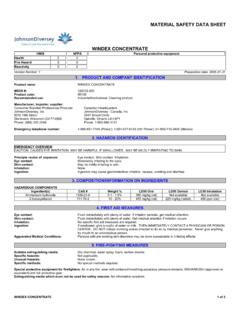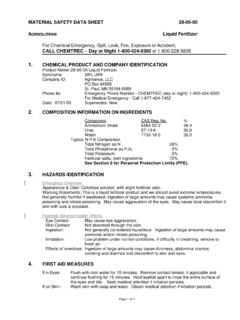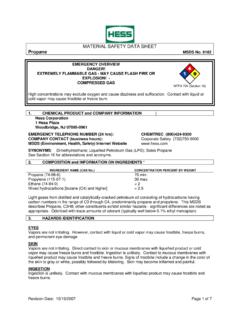Transcription of UNLEADED GASOLINE (ALL GRADES) MATERIAL SAFETY …
1 MSDS No: PEG-UNL Page 1 of 13 03/05/2008 UNLEADED GASOLINE ( all grades ) MATERIAL SAFETY data sheet Petrocom Energy Group, LLC 1330 Post Oak Blvd., Suite 2350 Houston, Texas 77056 Phone: 713-418-3000 Fax: 713-418-3001 Revision Date: 03/05/2008 Section 1: Product Identification Name: UNLEADED GASOLINE Synonyms: Regular/Midgrade/ premium GASOLINE , Motor Fuel, Reformulated GASOLINE , RFG, Conventional GASOLINE . CAS No.: 86290-81-5 MSDS No.: PEG-UNL Use: Motor fuel Section 2: Product Composition Component CAS Number Amount (%) GASOLINE 86290-81-5 0 100 Benzene 71-43-2 0 5 Toluene 108-88-3 0 30 Xylene (all isomers) 1330-20-7 0 25 Hexane (other isomers)
2 Mixture 5 25 n-Hexane 110-54-3 0 3 Cyclohexane 110-82-7 0 3 Octanes (all isomers) Mixture 0 20 Heptane (all isomers) 142-82-5 0 15 Ethanol 64-17-5 0 10 Pentanes (all isomers) Mixture 0 20 Trimethylbenzenes (all isomers) 95-63-6 0 5 Ethylbenzene 100-41-4 0 5 Cumene 98-82-8 0 5 Methyl Tertiary Butyl Ether (MTBE) 1634-04-4 0 16 Tertiary Amyl Methyl Ether (TAME) 994-05-8 0 6 MSDS No.
3 PEG-UNL Page 2 of 13 03/05/2008 Petrocom Energy Group, LLC MSDS UNLEADED GASOLINE ( all grades ) Section 3: Hazards Identification Emergency Overview DANGER! Extremely Flammable liquid and vapor Harmful if swallowed Skin Irritant May cause eye and respiratory irritation Cancer Hazard Contains MATERIAL which can cause cancer Hazard Rankings NFPA Physical form: Liquid Appearance: Clear to amber Odor: Strong, GASOLINE Potential Health Effects Eyes: Contact with eyes may cause irritation, redness, tearing, stinging, watering and blurred vision. Skin: Contact with skin may cause irritation, itching, redness and skin damage. Prolonged or repeated contact may cause drying and cracking of the skin, and may also cause dermatitis and inflammation. (See also section 11). Inhalation: Breathing high concentration can be harmful. Throat and lung irritation may occur.
4 Central nervous system effects including nausea, euphoria, dizziness, headache, fatigue, drowsiness or unconsciousness may occur due to long term or high concentration exposure to vapors. Ingestion: Toxic if swallowed. This product may cause nausea, vomiting, dizziness, drowsiness, diarrhea if swallowed. Central nervous system effects may be caused. Swallowing this product can result in severe lung damage and/or death. Signs / Symptoms: When overexposed to this product effects such as nausea, vomiting, blurred vision, respiratory failure, central nervous system depression, unconsciousness, tremor, death may occur. See toxicological Information (section 11) 13 0 MSDS No: PEG-UNL Page 3 of 13 03/05/2008 Petrocom Energy Group, LLC MSDS UNLEADED GASOLINE ( all grades ) Section 4: First Aid Measures Eye contact: Flush eyes immediately with fresh, cool water for at least 15 minutes. If irritation or redness or any symptoms persist, seek medical attention.
5 Skin contact: Remove contaminated clothes and shoes. Flush affected area with large amounts of water. If skin surface is damaged, apply a clean dressing and seek medical attention. If skin surface is not damaged, wash affected area thoroughly with soap and water. If irritation or redness develops, seek medical attention. Inhalation (Breathing): If inhaled, immediately move person to fresh air. If there is difficulty breathing, give oxygen. If not breathing, immediately give artificial respiration. Seek medical attention. Ingestion (Swallowing): This product may be harmful or fatal if swallowed. This product may cause nausea, vomiting, diarrhea and restlessness. Do not induce vomiting. Do not give anything by mouth because this MATERIAL can enter the lungs and cause severe lung damage. If victim is unconscious or drowsy, place on the left side with the head down. Seek immediate medical attention. Notes to Physician: This MATERIAL sensitizes the heart to the effects of sympathomimetic amines.
6 Epinephrine and other sympathomimetic drugs may initiate cardiac arrhythmias in individuals exposed to this MATERIAL . Inhalation overexposure can produce toxic effects. Monitor respiratory distress. If difficulty in breathing evaluate upper respiratory tract inflammation, bronchitis and pneumonitis. Administer supplemental oxygen as required. If ingested, this MATERIAL presents a significant aspiration and chemical pneumonitis hazard. Cinsuder activated charcoal and/or gastric lavage. If patient is obtunded, protect the airway by cuffed endotracheal intubtion or by placement of the body in a Trendelenburg and left lateral decubitus position. MSDS No: PEG-UNL Page 4 of 13 03/05/2008 Petrocom Energy Group, LLC MSDS UNLEADED GASOLINE ( all grades ) Section 5: Fire Fighting Measures NFPA Hazard Class: Health = 1 ; Flammability = 3 ; Instability = 0 (0 Minimal ; 1 Slight ; 2 Moderate ; 3 Serious ; 4 Severe) Auto ignition temperature : >260 C (500 F) Flash point : Closed cup: -43 C (-45 F) Flammable limits : Lower: approximately Upper: approximately Products of combustion : Carbon monoxide, carbon dioxide, nitrogen and sulfur oxides, smoke, fumes, unburned hydrocarbons and other products of incomplete combustion.
7 Special properties : Flammable liquid! This MATERIAL can be ignited by heat, sparks, flames or other sources of ignition. Vapors may travel long distances to a source where they can ignite and flash back, or explode. A mixture of vapor and air can create an explosion hazard in confined spaces. If container is not properly cooled, it can rupture n the heat of a fire. Extinguishing media : Use of dry chemical, carbon dioxide, or foam is recommended to extinguish fire. Water spray is recommended to cool or protect exposed materials or structures. Carbon dioxide can displace oxygen. Use caution when applying carbon dioxide in confined spaces. Water may not extinguish the fire, unless it is used by experienced fire fighters and under favorable conditions. Protective Equipment for : Fire fighters should wear appropriate protective equipment and Fire Fighters self contained breathing apparatus (SCBA) with a full face piece operated in positive pressure mode.
8 13 0 MSDS No: PEG-UNL Page 5 of 13 03/05/2008 Petrocom Energy Group, LLC MSDS UNLEADED GASOLINE ( all grades ) Section 6: Accidental Release Measures Personal precautions: This MATERIAL is extremely flammable. Eliminate all ignition sources. Keep all hot metal surfaces away from spill/release. All equipment used when handling this MATERIAL must be grounded. Spill precautions: Stay upwind and away from spill. Notify persons down wind of the spill, isolate spill area and keep unauthorized personnel out. If it can be done with minimal risk, try to stop spill. Always wear protective equipment, including respiratory protection. Contact emergency personnel. Environmental precautions: Prevent spilled MATERIAL from entering sewers, drains, soil, and natural waterways. Use foam or spills to minimize vapors (section 5). Spilled MATERIAL may be absorbed into an appropriate absorbent MATERIAL . Methods for cleaning up: Notify fire authorities and appropriate federal, state and local agencies.
9 Immediate cleanup is recommended. Section 7: Handling and Storage Handling: Flammable liquid and vapor. To be used only as a motor fuel. Avoid inhalation of vapors and contact with skin. Wash hands thoroughly after handling this MATERIAL . Use in a well ventilated area away from all ignition sources. Use product with caution around heat, sparks, static electricity and open flames. Static electricity may ignite vapors and cause fire. Empty containers retain residue and may be dangerous. Do not pressurize, cut, weld, braze, solder, drill, grind, or expose such containers to heat, flame, sparks or other ignition sources. The may explode and cause injury and/or death. Empty drums should be completely drained, properly bunged, and returned promptly to a drum reconditioner. All containers should be disposed of in an environmentally safe manner and in accordance with governmental regulations. Storage: Store in approved containers only. Keep in tightly closed containers in cool, dry, well ventilated areas.
10 Keep isolated away from heat, sources of ignition and hot metal surfaces. MSDS No: PEG-UNL Page 6 of 13 03/05/2008 Petrocom Energy Group, LLC MSDS UNLEADED GASOLINE ( all grades ) Section 8: Exposure Controls / Personal Protection Engineering controls: Provide ventilation or other engineering controls to keep the airborne concentrations of vapor or mists below their occupational exposure limits. Eyewash stations and SAFETY showers should be located near the work-station. Personal Protection Eye Protection: Keep away from eyes. SAFETY glasses complying with approved standards should be worn. Chemical type goggles should be worn. Skin Protection: Keep away from skin. Skin protection should be worn. Chemical resistant, impervious gloves should be worn. Always follow good personal hygiene practices after handling the MATERIAL . Respiratory Protection: Approved respiratory equipment must be used if a risk assessment indicates it is necessary.



